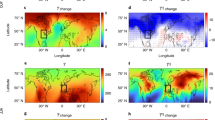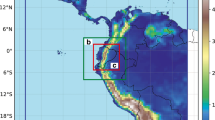Abstract
Spatial patterns of the standard deviation and skewness of daily and monthly mean summer temperature were studied with the climate model Institute of Numerical Mathematics Climate Model version 4 for three scenarios: simulation of the preindustrial climate, effect of quadrupling CO2 concentrations, and simulation of transient climate change for the period 1850–2100. In high skewness regions of the simulated preindustrial climate, hot periods exceeded the number expected for a normal distribution by a factor of 2–8. In the model in which CO2 concentrations were quadrupled, we found an increase in standard deviation and a northward shift of the area with positive skewness compared with the preindustrial scenario. The maximum increase in summer mean temperature was found in subtropical areas. The maximum increase in temperature averaged over the warmest 30 % of days was about 500 km to the north of the region of maximum increase of seasonal mean temperature, in the area where standard deviation was increased. The maximum increase in temperature averaged over the warmest 0.1 % of days was 500 km further north again, in an area of increased skewness. In the transient climate change simulation for 1850–2100, there was a noticeable increase in temperature of the warmest days exceeding the summer mean temperature in regions with increased skewness. In regions with decreased skewness, there was only a small increase or no rise at all in temperature for the warmest days under transient global warming.










Similar content being viewed by others
References
Barriopedro D, Fischer EM, Luterbacher J, Trigo RM, Garcia-Herrera R (2011) The hot summer of 2010: redrawing the temperature record map of Europe. Science 8:220–224
Brabson BB, Lister DH, Jones PD, Palutikof JP (2005) Soil moisture and predicted spells of extreme temperatures in Britain. J Geophys Res 110:D05104. doi:10.1029/2004JD005156
Clark R, Brown S, Murphy J (2006) Modelling Northern Hemisphere summer heat extreme changes and their uncertainties using a physics ensemble of climate sensitivity experiments. J Clim 19:4418–4435
Fischer EM, Schär C (2009) Future changes in daily summer temperature variability: driving processes and role for temperature extremes. Clim Dyn 33:917–935
Fischer EM, Schär C (2010) Consistent geographical patterns of changes in high-impact European heatwaves. Nat Geosci 3:398–403. doi:10.1038/ngeo866
Fischer EM, Seneviratne SI, Luthi D, Schär C (2007) Contribution of land–atmosphere coupling to recent European summer heat waves. Geophys Res Lett 34. doi:10.1029/2006GL029068
Kharin VV, Zwiers FW (2005) Estimating extremes in transient climate change simulations. J Clim 18:1156–1173
Kharin VV, Zwiers FW, Zhang X, Hergel GC (2007) Changes in temperature and precipitation extremes in the IPCC ensemble of global coupled model simulations. J Clim 20:1419–1444
Koster RD, Suarez MJ, Schubert SD (2006) Distinct hydrological signatures in observed historical temperature fields. J Hydrometeorol 7:1061–1075
Lenderink G, Ulden A, Hurk B, Meijgaard E (2007) Summertime interannual temperature variability in an ensemble of regional model simulations: analysis of the surface energy budget. Clim Chang 81:233–247
Meehl GA, Tebaldi C (2004) More intense, more frequent, and longer lasting heat waves in the 21th century. Science 305:994–997
Meehl GA, Stocker TF, Collins WD, Friedlingstein P, Gaye AT, Gregory JM, Kitoh A, Knutti R, Murphy JM, Noda A, Raber SCB, Watterson IG, Weaver AJ, Zhao ZCZ (2007) Global climate projections. In: Solomon S, Qin D, Manning M, Chen Z, Markuis M, Averyt KB, Tignor M, Miller HL (eds) Climate change 2007: the physical science basis. Contribution of working group I to the fourth assessment report of the intergovernmental panel on climate change. Cambridge University Press, Cambridge
Mitchell TD, Jones PD (2005) An improved method of constructing a database of monthly climate observations and associated high-resolution grids. Int J Climatol 25:693–712
Razuvayev VN, Apasova EG, Martuganov RA, Steurer P, Vose R (1993) Daily temperature and precipitation data for 223 U.S.S.R. Stations. ORNL/CDIAC, Numerical data package-040. Oak Ridge National laboratory, Oak Ridge
Schär C, Vidale L, Luthi D, Frei C, Haberli C, Liniger MA, Appenzeller C (2004) The role of increasing temperature variability in European summer heat waves. Nature 427:332–336
Seneviratne SI, Luthi D, Litschi M, Schär C (2006) Land–atmosphere coupling and climate change in Europe. Nature 433:205–209. doi:10.1038/nature05095
Stott PA, Stone DA, Allen MR (2004) Human contribution to the European heatwave of 2003. Nature 432:610–614
Tebaldi C, Haykoe K, Arblaster JM, Meehl JA (2006) Going to the extremes: an intercomparison of model-simulated historical and future changes in the extreme events. Clim Chang 79:185–211
Volodin EM, Lykossov VN (1998) Parameterization of heat and moisture transfer in the soil-vegetation system for use in atmospheric general circulation models. 1. Formulation and simulations based on local observational data. Izvestia RAS. Atmospheric Ocean Phys 34:405–416
Volodin EM, Dianskii NA, Gusev AV (2010) Simulation present day climate with the INMCM4.0 coupled model of the atmospheric and oceanic general circulations. Izvestia RAS. Atmospheric Ocean Phys 46:414–431
Yonetani T, Gordon HB (2001) Simulated changes in frequency of extremes and regional features of seasonal/annual temperature and precipitation when atmospheric CO2 is doubled. J Clim 14:1765–1779
Acknowledgments
The study was supported by Russian Fund of Basic Research, grant 09-05-00681.
Author information
Authors and Affiliations
Corresponding author
Rights and permissions
About this article
Cite this article
Volodin, E.M., Yurova, A.Y. Summer temperature standard deviation, skewness and strong positive temperature anomalies in the present day climate and under global warming conditions. Clim Dyn 40, 1387–1398 (2013). https://doi.org/10.1007/s00382-012-1447-4
Received:
Accepted:
Published:
Issue Date:
DOI: https://doi.org/10.1007/s00382-012-1447-4




